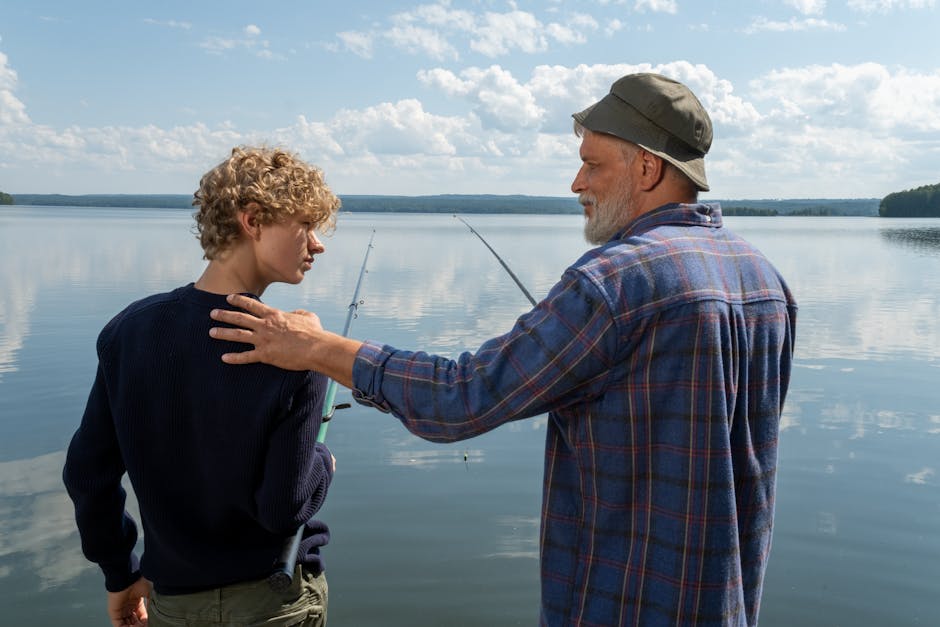Introduction to Family Fishing: A Fun Bonding Activity
Family fishing isn’t just about the catch—it’s about creating memories together. Think of it as a chance to unplug from the day-to-day and reconnect with each other. Whether you’re casting lines on a serene lake or waiting for a bite along a bubbling stream, it’s a wholesome activity everyone can get hooked on. Don’t fret over not being an expert; fishing can be enjoyed by all ages and skill levels. It involves picking a spot, setting up your gear, casting your line, and waiting for that thrilling tug. It’s that simplicity that can bring laughter, teach patience, and foster conversations. Plus, it’s a learning opportunity, as you’ll get to know about different fish species, techniques, and the importance of respecting nature. So grab your tackle box, bait your hooks, and get ready to introduce your kin to the joys of fishing—it’s an easy way to turn an ordinary day into an adventure.

What You Need to Get Started with Family Fishing
To get started with family fishing, you need a simple set of gear and a positive attitude. Grab a basic fishing rod and reel combo suited for beginners, spooled with light to medium weight line, which makes sense for most types of fish you’ll encounter at local spots. Make sure you have a tackle box with essentials: various hooks, sinkers, and a few bobbers. You’ll also want an assortment of lures or live bait, which many fish find irresistible. Don’t forget a valid fishing license for the adults; you can usually purchase them online or at local bait shops. Lastly, pack sun protection, snacks, and plenty of patience — fishing is as much about the wait as it is about the catch. With the right gear and mindset, you’re ready to create lasting memories by the water.
Choosing the Right Fishing Spot for Your Family
Picking the right fishing spot is vital for a fun family outing. You want a place that’s safe, accessible, and has an aboundance of fish. Freshwater spots like lakes and rivers are great for starters—they generally have plenty of panfish, which are easy to catch and keep kids engaged. For variety, saltwater spots like piers or shallow beaches could offer more challenge with different fish types. Key factors for your decision should include weather conditions, local fishing regulations, and potential amenities like picnic areas and restrooms. Always check online forums or stop by a local bait shop—they’re the goldmine for up-to-date fishing information in the area. Remember, a spot that’s popular and bustling with other families will likely be more comfortable for your first fishing experience.
Understanding Fishing Regulations: Rules and Licenses
Before you even think about hitting the water, you gotta know the rules. Fishing regulations are in place to protect fish populations and make sure there’s enough to go around for future anglers. Each state has its own set of regulations you must follow, including what kinds of fish you can catch, how many you’re allowed to keep, and what size they’ve got to be before you reel them in. And don’t forget, nearly every place will require that you have a fishing license. You can usually grab one online, at a local tackle shop, or sometimes even at a big box store. It’s pretty straightforward: no license, no fishing. It’s tempting to test your luck, but getting caught without one can land you a hefty fine, and that’s no fish tale. Stay legal, respect the waters, and enjoy your time out there with the fam.
Essential Gear for a Family Fishing Trip
Alright, let’s talk gear for your family fishing adventure. Gotta keep it simple, but make sure we got the basics. First off, you’ll need a fishing rod and reel for each person. No need for anything fancy, a simple, durable setup will do the trick. Then, grab a tackle box. Inside, stash an assortment of hooks, sinkers, and bobbers. These little guys are must-haves for snagging fish. And don’t forget the bait – worms often get the job done, but bring a variety if you’re feeling adventurous. Next, a good old fishing line, strong enough to hold your potential catches. Also, toss in a pair of pliers and a knife, they’re handy for removing hooks and cutting line. Sun protection is key, so pack sunscreen, hats, and sunglasses to shield your gang from the rays. Round it out with a first aid kit, because better safe than sorry, right? And hey, if you plan to keep your catch, don’t overlook a cooler with ice. Keep it all in check, and you’re set for a great time by the water. Happy fishing!
Bait Selection: Matching the Fish You Want to Catch
Choosing the right bait is crucial to your success in family fishing, just like a warrior selects their weapons. Different fish have different tastes, so you want to match your bait to the fish you’re aiming to catch. If you’re after trout, you might use worms or insects since those are a natural part of a trout’s diet. For bass, consider lures that mimic small fish or use live bait like crawfish that bass can’t resist. Catfish are less picky and will go for stink baits and chicken livers, because they’re attracted to strong smells. It’s a simple strategy—think like your fish, and you’ll be reeling them in in no time. Remember, the sharper your bait strategy, the better your chances of a great catch. So pick your bait wisely, it’s the first step in your fishing adventure.
Tips for Making Fishing Fun and Safe for Kids
Getting kids hooked on fishing involves more than casting a line – you have to make it fun and safe too. First off, pick a spot where they are likely to catch something; instant action can boost their excitement. Choose simple tackle – small hooks, bobbers, and a light line make for a kid-friendly setup. Teach them the safety basics: no swinging hooks or running near the water. And remember, patience is key. Celebrate every catch, no matter the size, and keep snacks on hand for those slower moments. Make it a learning adventure; let them throw in a line and reel in the memories.
Catch-and-Release vs. Keep: Ethical Fishing Practices
When you’re out there on the water, you’ve got a choice to make: do you keep your catch or let it swim free? Catch-and-release fishing is all about the thrill of the catch without taking the fish home. It’s a sportsman’s game – you reel ‘em in, pat yourself on the back, then gently set them back in the water. The trick here is to handle the fish with care, ensuring they’re in good shape to survive. Now, if you decide to keep your catch, that’s fine too, but be responsible. Only take what you need and follow local fishing regulations to the letter. Remember, fishing’s not just about you; it’s about respecting the ecosystem. Keep the fish populations healthy for everyone, including the fish.
Handling Your Catch: Basic Fish Cleaning and Cooking Tips
Once you’ve landed your fish, the real work begins. You need to clean it before you can cook it. Start by scaling the fish – hold it by the tail and use a knife or a fish scaler to remove scales, moving from tail to head. Next, open the belly and remove the guts. Make sure you’re thorough and rinse the cavity out well. Now you can fillet the fish or cook it whole. For cooking, simplicity is key. Fresh fish tastes great when it’s grilled, pan-fried, or baked with just a touch of salt, pepper, and maybe a squeeze of lemon. Remember, the fresher the fish, the simpler the cooking method can be, so let the natural flavors shine. Keep it straightforward, cook it right, and you’ll have a meal that’s hard to beat.
Wrapping Up the Day: Memories Made and Lessons Learned
When the hooks are reeled in and the sun starts its descent, that’s when you realize family fishing isn’t just about the catch—it’s about the moments shared. After a day spent by the water, you’ll find stories bloomed with each cast line. Little Johnny’s triumphant grin holding his first catch, or Sarah’s unexpected tug-of-war with a stubborn fish, become cherished tales. These memories stick, often stronger than the day’s biggest haul. And it’s not just the laughs or the fish count tally; it’s the lessons too. Patience when the water’s still, resilience when the line snaps, and the satisfaction of teamwork as you pack up. You might have started the day as novices, but you wrap up richer in experience and with a deeper bond. So, stash the rods, but keep the stories as trophies – till next time, because this is one activity where everyone’s eager to cast again.

Leave a Reply